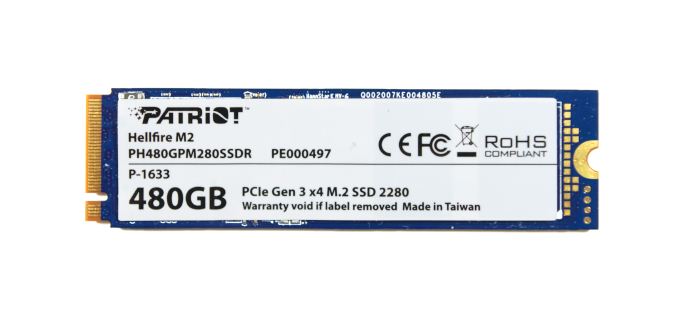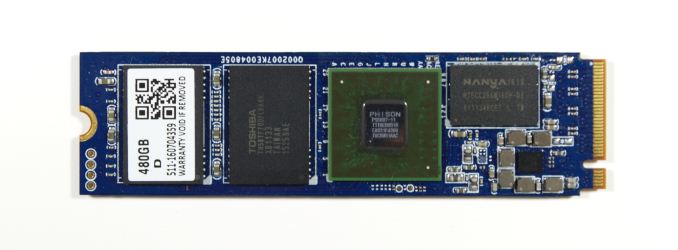The Patriot Hellfire M.2 480GB Review: Phison NVMe Tested
by Billy Tallis on February 10, 2017 8:30 AM EST
The Patriot Hellfire M.2 PCIe SSD is Patriot's first NVMe SSD, and one of several similar products based on Phison's E7 NVMe controller. As usual for Phison, the same drive is manufactured for many of their partners, who typically customize only the branding. Phison designs the controller, firmware, and PCB, but leaves the marketing up to their partners.
Phison's PS5007-E7 controller is their first NVMe SSD controller, supporting a PCIe 3.0 x4 host interface and 8 channels for NAND access. The details we have on the E7 are a bit slim - some collection of ARM cores under the hood is a safe bet, but that's it - however we do know that the E7 controller is manufactured on TSMC's 28nm process and uses FCBGA packaging. Interestingly, it doesn't use the kind of large heatspreader we've seen on competing controllers like Silicon Motion's SM2260. Phison had the E7 platform hardware ready over a year ago, but retail releases were held back by the poor performance of early firmware. Patriot first began shipping the Hellfire last fall, but even after that much delay, they ended up issuing a firmware update shortly after launch.
Phison's controllers are almost always paired with Toshiba's NAND flash, and the Patriot Hellfire uses Toshiba's 15nm MLC. Our review sample is the 480 GB version, the most common capacity for E7 SSD. Patriot also sells a 240 GB version, and some of their competitors offer the 120GB version as well.
| Patriot Hellfire Specifications Comparison | |||
| 240 GB | 480 GB | ||
| Form Factor | M.2 2280 | ||
| Controller | Phison PS5007-E7 | ||
| Interface | NVMe PCIe 3.0 x4 | ||
| DRAM | 256MB DDR3L | 512MB DDR3L | |
| NAND | Toshiba 15nm MLC | ||
| Sequential Read (CDM) | 2740 MB/s | 2550 MB/s | |
| Sequential Write | 1090 MB/s | 1260 MB/s | |
| 4KB Random Read (QD32) | 170k IOPS | 170k IOPS | |
| 4KB Random Write (QD32) | 185k IOPS | 210k IOPS | |
| Warranty | 3 years | ||
| MSRP | $130 (54¢/GB) | $230 (48¢/GB) | |
The Phison E7 controller was originally intended to be a high-end NVMe controller for client or enterprise use. By the time it was ready for the market, Samsung had raised the bar far too high for the E7 to still be considered high-end. But Phison E7-based SSDs like the Patriot Hellfire have been able to offer very attractive pricing and are usually the cheapest MLC-based NVMe SSDs available. Without the pitfalls of TLC-based SSDs like the Intel SSD 600p and the Samsung 960 EVO, the Patriot Hellfire and its relatives have been attractive entry-level PCIe SSD options.
Aside from other Phison E7 SSDs, the closest competition for the Patriot Hellfire is the Plextor M8Pe, based on the same Toshiba 15nm MLC NAND but using the Marvell 88SS1093 controller with Plextor's own firmware. The Patriot Hellfire also has to justify its higher price relative to the Intel SSD 600p, the most affordable NVMe SSD, and against high-performing SATA SSDs like Samsung's 850 EVO and 850 PRO.
| AnandTech 2015 SSD Test System | |
| CPU | Intel Core i7-4770K running at 3.5GHz (Turbo & EIST enabled, C-states disabled) |
| Motherboard | ASUS Z97 Pro (BIOS 2701) |
| Chipset | Intel Z97 |
| Memory | Corsair Vengeance DDR3-1866 2x8GB (9-10-9-27 2T) |
| Graphics | Intel HD Graphics 4600 |
| Desktop Resolution | 1920 x 1200 |
| OS | Windows 8.1 x64 |
- Thanks to Intel for the Core i7-4770K CPU
- Thanks to ASUS for the Z97 Deluxe motherboard
- Thanks to Corsair for the Vengeance 16GB DDR3-1866 DRAM kit, RM750 power supply, Carbide 200R case, and Hydro H60 CPU cooler











43 Comments
View All Comments
Magichands8 - Friday, February 10, 2017 - link
The problem is that there's nothing cheap about these. In fact, price per GB for SSDs seems to be going up even for the 'just good enough' crowd! And after all these years capacities are still a joke. To me, those are much bigger concerns than the name given to the drive. But we're going to have to put up with it for quite a while by simply not buying anything. Companies are going to keep doing this as there's apparently a large part of the buying public who are determined to throw pearls before swine on overpriced and low capacity SSDs. At least Patriot has done SOMETHING about the performance aspect.Murloc - Friday, February 10, 2017 - link
you're wrong, I can now buy something double the size and with better performance at the same price I bought my 840 evo.MR_Roberto - Monday, February 27, 2017 - link
ehh? tell me what product that is.. i want to buy it xDphexac - Friday, February 10, 2017 - link
Now, that is one crappy SSD.jjj - Friday, February 10, 2017 - link
You guys should use these traces to measure power consumption in CPU reviews.There is way too much focus on "max load". Guess AT does have some more relevant tests for laptop reviews but in CPU reviews, the power section is tragic.
Billy Tallis - Friday, February 10, 2017 - link
Unfortunately, these traces are just playing back the I/O, not actually re-running the whole application. The CPU load they present is trivial.jjj - Sunday, February 12, 2017 - link
Hmm so that can distort the SSD perf tests a bit for workloads that are CPU heavy.Maybe a dedicated article would be interesting. Even more so when you get Xpoint drives, next year i guess for proper capacities.
Guess the SSD power tests could factor in perf and CPU utilization for extra accuracy.
Billy Tallis - Monday, February 13, 2017 - link
The distortion should be minimal. Recording the traces in the first place incurred very little overhead. The trace doesn't perfectly capture the dependencies between operations, but the playback does preserve the ordering and queue depths and relative timing, except that long disk idle periods are cut short. I'll cover this in detail in when I launch the 2017 test suite.BurntMyBacon - Monday, February 13, 2017 - link
Your efforts are appreciated.jjj - Monday, February 13, 2017 - link
Just to be clear, i was thinking the CPU becoming a bottleneck in some situations and that there might be significant differences in CPU load per unit of perf between SSDs that could lead to significant differences in real usage.